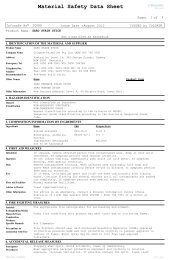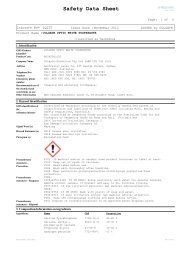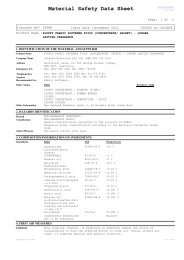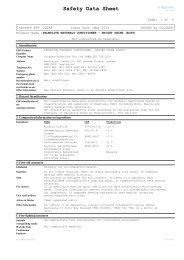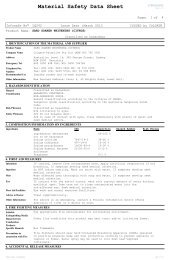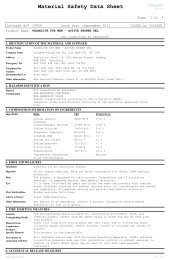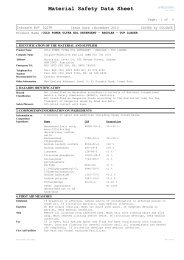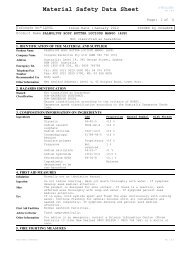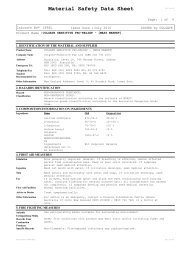Palmolive Naturals Shampoo - Colgate
Palmolive Naturals Shampoo - Colgate
Palmolive Naturals Shampoo - Colgate
Create successful ePaper yourself
Turn your PDF publications into a flip-book with our unique Google optimized e-Paper software.
Safety Data Sheet<br />
CS: 1.6.21<br />
Page: 2<br />
of<br />
5<br />
Infosafe No LPUN6 Issue Date : February 2013 ISSUED by COLGATE<br />
Product Name :PALMOLIVE NATURALS SHAMPOO ANTIDANDRUFF<br />
5. Fire-fighting measures<br />
Suitable<br />
extinguishing media<br />
Hazards from<br />
Combustion<br />
Products<br />
Specific hazards<br />
arising from the<br />
chemical<br />
Decomposition Temp.<br />
Precautions in<br />
connection with Fire<br />
Not classified as hazardous<br />
Use appropriate fire extinguisher for surrounding environment.<br />
Under fire conditions this product may emit toxic and/or irritating fumes and<br />
gases including carbon monoxide and carbon dioxide.<br />
This product is non-combustible. However, following evaporation of aqueous<br />
component under fire conditions, the non-aqueous component may decompose<br />
and/or burn.<br />
Not available<br />
6. Accidental release measures<br />
Emergency<br />
Procedures<br />
7. Handling and storage<br />
Precautions for Safe<br />
Handling<br />
Conditions for safe<br />
storage, including<br />
any incompatabilities<br />
8. Exposure controls/personal protection<br />
Occupational<br />
exposure limit values<br />
Fire-fighters should wear full protective clothing and self contained<br />
breathing apparatus (SCBA) operated in positive pressure mode.<br />
Slippery when spilt - avoid accidents. Wear appropriate personal protective<br />
equipment and clothing to minimise exposure. Increase ventilation. If possible<br />
contain the spill. Place inert absorbent material onto spillage. Collect the<br />
material and place into a suitable labelled container. Do not dilute material<br />
but contain. Dispose of waste according to the applicable local and national<br />
regulations. If contamination of sewers or waterways occurs inform the local<br />
water and waste management authorities in accordance with local regulations.<br />
Avoid contact with eyes. Industrial applications: Use only in a well<br />
ventilated area. Keep containers sealed when not in use. Prevent the build up<br />
of mists or vapours in the work atmosphere. Avoid inhalation of vapours and<br />
mists, and skin or eye contact. Maintain high standards of personal hygiene<br />
i.e. Washing hands prior to eating, drinking, smoking or using toilet<br />
facilities.<br />
Store in a cool, dry, well-ventilated area. Keep containers closed when not in<br />
use. Store in suitable, labelled containers.<br />
No exposure value assigned for this material by Safe Work, Australia. However,<br />
the available exposure limits for ingredients are listed below:<br />
Safe Work, Australia Exposure Standards:<br />
Substance TWA STEL NOTICES<br />
ppm mg/m3 ppm mg/m3<br />
Diethanolamine 3 13 - - -<br />
Biological Limit<br />
Values<br />
Appropriate<br />
engineering controls<br />
Respiratory<br />
Protection<br />
Eye Protection<br />
TWA (Time Weighted Average): The average airborne concentration of a<br />
particular substance when calculated over a normal eight-hour working day, for<br />
a five-day week.<br />
STEL (Short Term Exposure Limit): The average airborne concentration over a 15<br />
minute period which should not be exceeded at any time during a normal<br />
eight-hour workday.<br />
No Biological limit available.<br />
No special engineering controls required. Industrial Applications: Provide<br />
sufficient ventilation to keep airborne levels below the exposure limits.<br />
Where vapours or mists are generated, particularly in enclosed areas, and<br />
natural ventilation is inadequate, a local exhaust ventilation system is<br />
required.<br />
Not required under normal conditions of use. Industrial Applications:<br />
Reference should be made to Australian Standards AS/NZS 1715, Selection, Use<br />
and maintenance of Respiratory Protective Devices; and AS/NZS 1716,<br />
Respiratory Protective Devices.<br />
Not required. However, avoid eye contact. Industrial Applications: Eye<br />
protection should conform with Australian/New Zealand Standard AS/NZS 1337 -<br />
Eye Protectors for Industrial Applications<br />
Print Date: 11/02/2013 CS: 1.6.21



